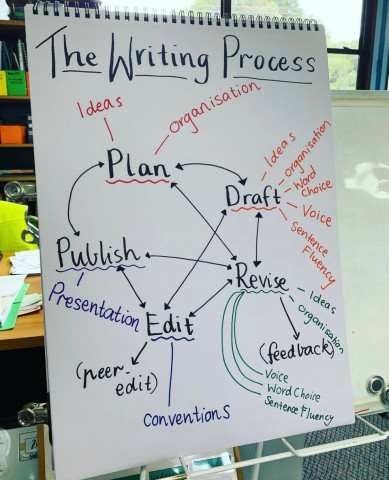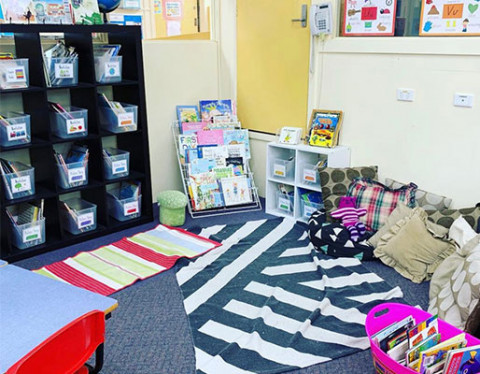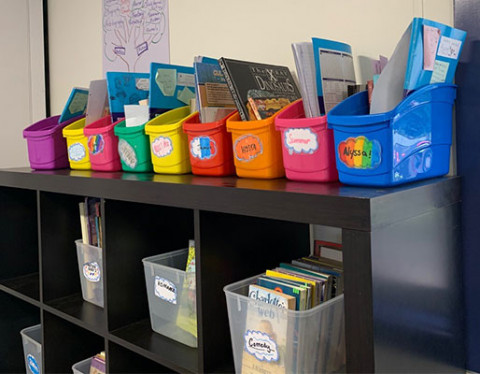Published 03 Jun 2022
Engaging teachers in professional learning using the Workshop Model - Clarinda Primary School
Engaged in and applied professional learning
Erin Beissel – Literacy Learning Specialist
Clarinda Primary School
Schools and early childhood services across Victoria continue to provide quality learning experiences across all levels. The VIT’s Professional Practice team is privileged to see this work first hand on visits to workplaces around the State. Here is just one example spotlighting the great work happening in a Victorian school.
Erin Beissel was awarded the Outstanding Primary Teacher winner at the 2021 Victorian Education Excellence Awards. We spoke to Erin about how implementing a new instructional model has improved skills and increased confidence in teaching literacy at her school.
Q: Can you give some background to the development of your approach to the initiative, including any research or established models / strategies that your approach is based upon?
In 2016, myself and fellow classroom teacher Dee McNamee completed the ‘Leading Literacy’ course through the Bastow Institute of Educational Leadership (see references below). This was where I first encountered the Workshop Model and learnt about the strong research behind this model of instruction.
Since then, we have implemented a new instructional model for teaching literacy called The Reader’s and Writer’s Workshop. This model is based on the Gradual Release of Responsibility model of instruction, and allows teachers to explicitly instruct students in core content and skills, then release responsibility to them to practice and improve their skills independently. This approach helps build new steps into our current practice and maintain consistency across the school.
The Workshop Model structure includes
- mini lessons - teachers review the learning intention and success criteria, and provide explicit, whole class instruction
- independent work time – students read or write independently and grow their skills by working in their Reader’s or Writer’s Notebook, and the teacher continues to give explicit feedback and instruction through one-on-one conferences and small focus groups
- sharing – students reflect on their learning and themselves as learners, and on how they have worked towards the success criteria for the day.
As part of this model, we have a strong focus on student choice, with students having ownership over what they read and write. Extensive time is provided within the workshop for students to practise reading and writing, with most of the hour lesson given for ‘independent work time’. This allows students to put into practise the skills and strategies they have learnt and become better readers and writers.
Q: What structural things are in place to ensure that the initiative has its best chance at success?
Over the last six years, the staff at Clarinda Primary School have engaged in ongoing, regular professional development to build on their knowledge, understanding and skills to implement the Workshop Model. Through whole school curriculum days and short after school professional learning sessions, we have added to our knowledge over time.
We began by introducing the Reader’s Workshop model in a basic format, and provided staff with knowledge and training in strategies and skills needed to implement it. As staff grew their practice in this area, we began to focus on other concepts of the Workshop (conferring, focus groups etc.).
We then moved on to introducing the Writer’s Workshop and brought in the 6+1 Traits of Writing as a language for teaching writing. Once staff were confident with this, we revisited the concept of the Workshop Model, and added to our understanding of how students and teachers can work within it.

Anchor charts are co-created with students during mini lessons and displayed in the classroom to reinforce learning - this anchor chart was created during a lesson on the writing process and prompts students to see themselves as authors.

Anchor charts are co-created with students during Mini Lessons and displayed in the classroom to reinforce learning - this anchor chart reminds students ways to track their thinking during independent reading.
This ongoing professional development has ensured that we have a consistent model of instruction across the school. By slowly building on our knowledge through regular professional development, we have allowed teachers to build confidence in their practice.
Other professional development engaged in
- staff book club – this was a core element of our professional learning and involved leadership selecting a textbook for all staff at the beginning of the year. Every few weeks, teachers would read one chapter after which we would come together in our regular meeting and have a discussion around the content, using a range of protocols to extend our knowledge and trial elements of practice within our classrooms. The staff book club was a great opportunity for teachers to go in depth with elements of our literacy model.
- coaching – this has been a key feature of our work, with our Literacy Learning Specialists making themselves available to work individually with staff. This has included modelling lessons in classrooms, team teaching with others or observing teacher practice and providing feedback. It has also included meeting with classroom teachers during non-face-to-face-teaching time, hearing what they would like to work on or require assistance with and providing feedback, assistance and resources. Our Learning Specialists were also actively involved in writing curriculum documents as we progressed with our practice changes, which the Professional Learning Communities have taken and continued to revise and evolve each year.
- learning walks – these were used to maintain and build consistency of practice. Our leaders walked through the school and observed classes in action and used these learning walks to identify both strengths in practice, which were used to encourage staff, and areas to work on through future professional learning.
Q: What are the greatest benefits to staff development of this approach?
Through this ongoing professional learning, teachers at Clarinda Primary School are now confident in their ability to teach literacy.
For reading, teachers focus on a combination of decoding strategies (including phonics) and comprehension strategies explored through the Reader’s Notebook, and for writing they use the language of the 6+1 Traits and Writer’s Notebooks to encourage students to become strong, independent writers.
With coaching and curriculum support, teachers feel comfortable to ask for support and then challenge themselves to refine their practice and ensure they are best meeting the needs of all learners.
Q: What have been the benefits to learner outcomes of this approach?
In the Reader’s and Writer’s Workshop, students are given time and choice over what they want to independently read and write. This has had an enormous positive impact on student engagement in reading and writing.

Every class has a classroom library which includes a range of books on different topics, genres and levels of reading ability, with students taking ownership of how the library is organised.

Students use the class library to select Just Right Books which are kept in their book box, along with their Reader’s Notebook, ready for easy access during independent reading time.
Through whole class mini lessons, one-on-one conferences and small focus groups, every student is given explicit point-of-need instruction and works towards their own personal reading and writing goals, which benefits them greatly.
We have also seen growth in student voice and agency through both the choice to read and write things of interest, and the focus on allowing students to set their own goals in both subjects.
Q: What plans does your workplace have to take this approach forward?
Our school is continuing to provide coaching through the role of the Literacy Learning Specialist. Our Literacy and Numeracy Learning Specialists work closely together to plan the professional learning for our school and support the work of our Professional Learning Communities.
We are always looking to the future with where to go next with our professional learning. We know that we will never be ‘finished’ and we want to keep going further with our practice to ensure our students are getting the best possible learning.
Q: Can you detail any references or citations applicable?
- the Leading Literacy course through the Bastow Institute of Educational Leadership (now Victorian Academy of Teaching and Learning)
- our school literacy leaders have been supported by Education Consultant Danny Hyndman who has worked with our school since 2018
- resources that assist our curriculum development include texts by Debbie Miller, Ruth Culham, Heidi Ann Mesmer and Jennifer Serravallo.
Do you have an example of outstanding work in your school or early childhood service? We’d like to consider showcasing it the Excellence in Teaching section of our website. Send your example and contact details to vitcomms@vit.vic.edu.au.
